Last Updated: 10 months ago
Certainly, every cat is priceless to a pet lover.
However, in the cat breeders’ world, Russian breeds rank among the most expensive cats in the world.
All the more reason why every pet owner would love to know these kitties.
Let’s get started with one of my favorite breeds, the Donksoy cat.
#1 Donskoy Cat
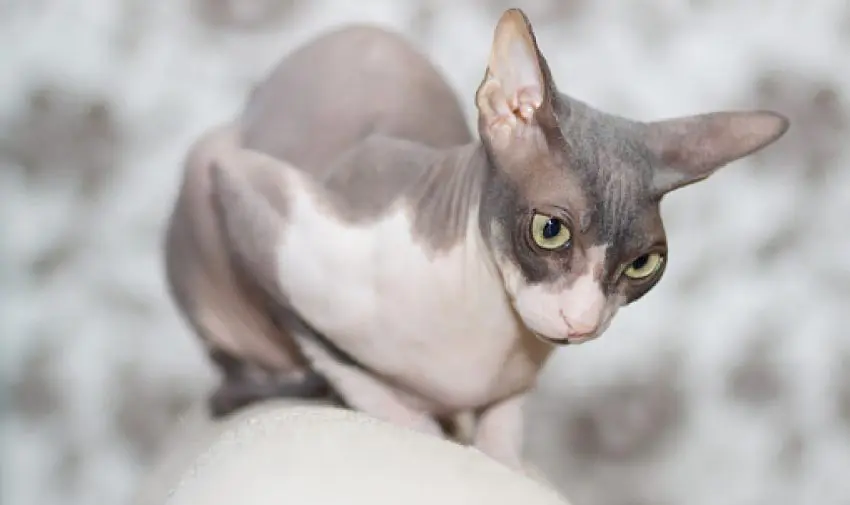
The Donskoy cat is sometimes called the Don Hairless or the Russian Hairless. That’s because of its typical hairless body.
According to The International Cat Association, this breed was discovered in a Russian city called Rostov-on-Don in 1987.
The discovery was fascinating since Elena Kovaleva, professor of the State Pedagogical Institute, rescued a hapless kitten from a group of young boys who were mistreating it.
The kitten grew up under Elena’s care and received unsuccessful treatments for hair loss.
The cat also gave birth to both hairy and hairless kittens. The bald kittens also experienced hair loss.
People later decided to get rid of the cats because they considered them unhealthy due to their hair loss.
Fortunately, Irina Nemikina, a professional cat breeder, rescued one hairless kitten and generated this new cat breed.
She initially named it the Don Sphynx. This cat is pretty special, beyond its unique hairless features.
The cat is brilliant and a loving feline that will look directly into your eyes, as if making a human connection with you.
At first glance, you may assume they are some form of extraterrestrial. Being hairless, you can visibly see their wrinkled skin, which gives them a seemingly wizened look.
They also have long, shell-like ears and almond-shaped eyes. It’s no surprise that this breed is highly prized for its striking and rare features.
#2 The Russian Blue
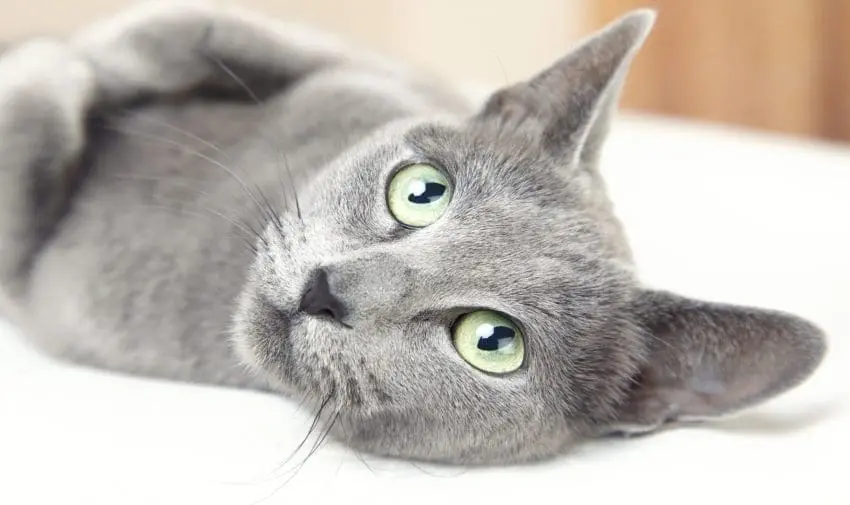
While the Donskoy is my favorite, this next kitty is perhaps the most well-known Russian cat breed.
Just as the name suggests, this fluffy grey cat has a beautiful shimmery blue coat, complemented by striking emerald eyes.
This elegance is further accentuated by the cat’s possible ties to Russian czars.
The ASPCA Pet Insurance reveals that Russian Blues belong to the same classification as the Korat of Thailand, the British Blue Cat, and the Chartreux of France.
But the Russian Blue is still a distinct breed, possessing unique features. They have bright green eyes and a wedge-shaped head.
The cat also has a slender body, which makes it stand out from its British, French, and Thai cousins. Those other cats tend to have rounder faces and stockier bodies.
This Russian Blue cat will grow to approximately 10 inches in height, weighing 7–15 pounds. The feline will live as long as 15–20 years or more!
Common names for this feline are Archangel Blue, Maltese Cat, or Foreign Blue. Since the cat is a naturally occurring breed, its true origin is not clear.
It’s likely that their origin is somewhere in northwest Russia. The prevailing theory is that the Russian Blue descended from the Russian czars’ esteemed pets.
Other people speculate that the first breed was a wild cat that lived in the wilderness and hunted for its prized pelts. But how did the breed come to Great Britain or Northern Europe?
Well, Russian sailors probably befriended the felines in the 1860s and brought them aboard their ships, particularly in the bustling port city of Arkhangelsk.
#3 Russian White Cat
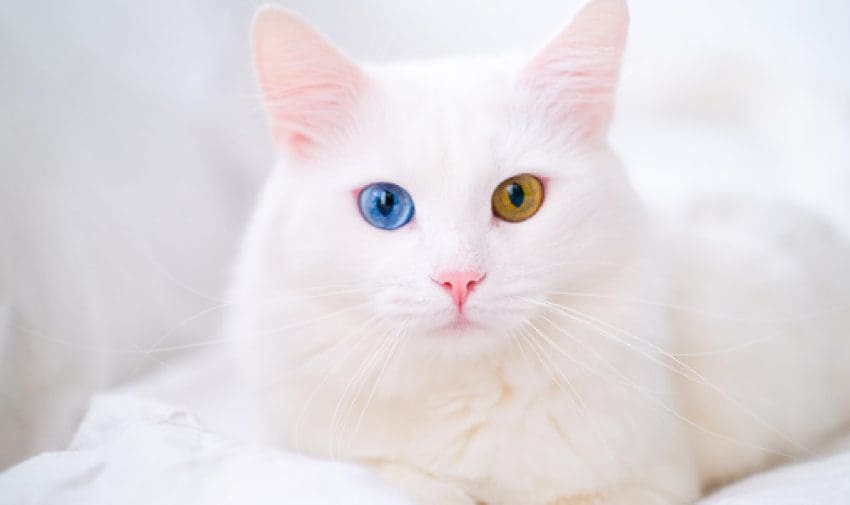
The Russian White cat is an affectionate, gentle, loving, and loyal breed.
As much as the breed tends to bond well with family members, it will typically remain indifferent toward strangers.
Admittedly, this breed is less known than the Russian Blue. The cat’s white coat masks the genetic blue color.
Fortunately, the Governing Council of the Cat Fancy (GCCF) reveals that you can check the breed through a DNA test.
Key features:
- a lifespan of 12–15 years
- an average height of 7.9–9.8 inches (20–25 cm)
- the female has an average weight of 7.7–11 lbs (3.5–5 kg)
- males have an average weight of 11–12 lbs (5–5.5 kg)
- the coat is delicate, svelte, short, and white
- some varieties have black or chocolate coats
- the elegant breed has a medium build
You won’t have to do too much work grooming this cat; a weekly brush would do. Moreover, the breed is generally healthy, although it is prone to bladder stones.
Being both intelligent and friendly makes this cat an exceptionally loving pet. You can even teach your cat cool little tricks like playing fetch, opening doors, and moving things to find treats.
The cat also has a pretty good memory and will remember people better than most breeds. However, Russian white cats aren’t particularly vocal, like Siamese.
#4 Kurilian Bobtail
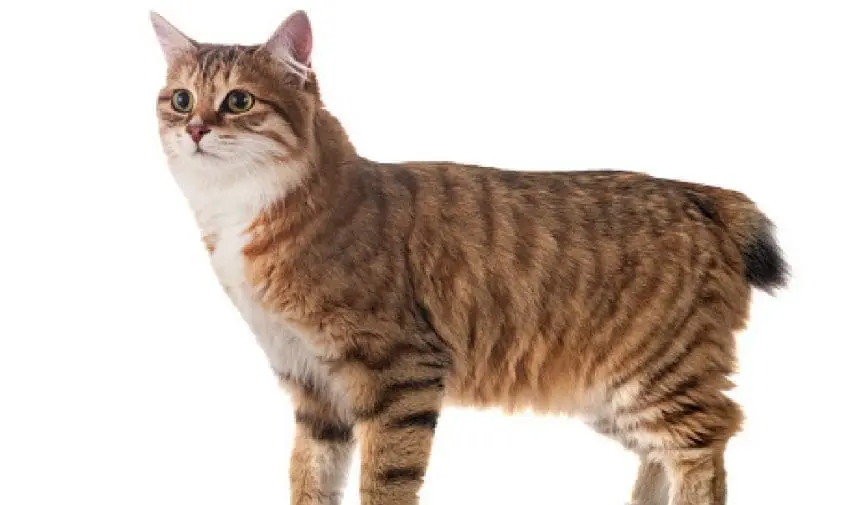
The Kurilian Bobtail gets its name from its place of origin: the Kuril Islands, which are claimed by Russia and Japan.
The cat may be either short or long-haired with a semi-cobby body and a short, fluffy tail.
Records from the American Cat Fanciers Association show that either scientists or military personnel first brought this breed to the Russian mainland in the middle of the 20th century.
The cat’s mouse hunting abilities make it quite popular in Russia. You’ll find the felines hunting in packs in the wild, just like wolves. Moreover, they love to swim.
The key characteristics of this cat include the following:
- a medium to large size
- a brawny build with substantial boning
- strong cat, well-muscled, with a wild appearance
- short or medium-long hair coat
- male cats can weigh as much as 15 pounds (6.8 kg), and the smaller females weigh 8–11 pounds (3.6–5 kg)
Just because this breed has a wild appearance doesn’t mean that it also has a wild character. On the contrary, the cat is quite gentle, trusting, and outgoing. It has an overall well-balanced character.
Your cat will adapt well to kids and other pets, making it a good family pet. This is one pet that loves affection.
What’s more, Kurilian Bobtails are very inquisitive, highly intelligent, and clever. Their athletic abilities complement these features.
It’s not surprising to see your pet jump to great heights to take the highest available spot for surveying their domain.
#5 Toybob
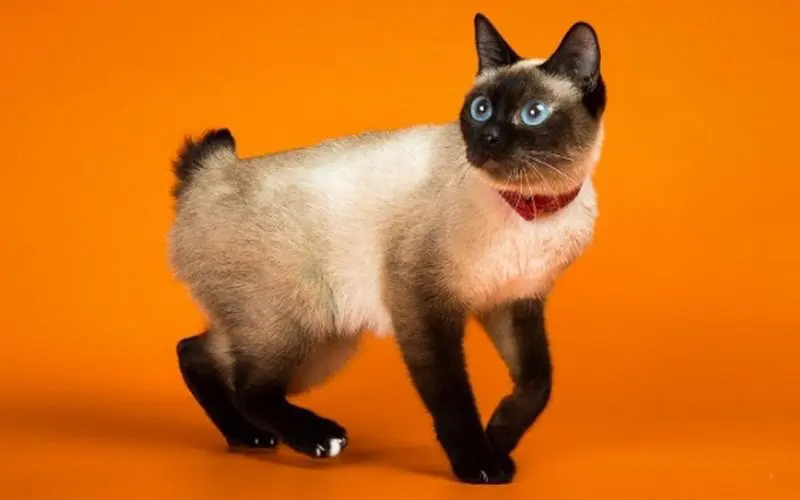
If you’ve ever wanted your kitten to remain a kitten forever, the Toybob is your best bet.
This breed is a small and cuddly cat that still looks like a kitten even when fully grown. The Cat Fanciers’ Association states that the Toybob originated in Russia in 1983.
This is one of the smallest cat breeds. And it isn’t a miniature version of a larger breed. Instead, it’s a naturally diminutive cat.
Apart from its small size, another unique feature it has is a kinked, bobbed tail. Fortunately, the bobbed tail isn’t a sign of impaired agility or poor health in the cat.
Toybobs come in many colors, too. It can have either a short or semi-long coat, which further complements its cuddly size.
That’s one reason for its popularity as a companion pet. Toybobs have a perky, charming, and playful personality.
They are not as active or vocal as high-energy breeds. These sweet, tiny kitties are content with being lap cats.
Don’t let the cat’s diminutive size deceive you. They are undoubtedly agile climbers and will perch high on top of furniture.
If you have soft pillows lying around, you’ll find your pet snuggling into them. Being loving and social, they’ll gaze at you with soulful eyes, inviting pampering and accepting it warmly.
#6 The Siberian

The Siberian is a powerful and highly intelligent cat breed.
But they are also soft at heart and get along with everyone, including dogs. That’s why some people refer to them as gentle giants.
According to the ASPCA Pet Insurance, these cats originated in the dense Siberian forests some 1,000 years ago. Some people even believe this breed is the ancestor of all modern longhair cats.
Although their early lives are unknown, these cats were probably domesticated when they escaped the brutal Siberian cold and sought shelter in farms, shops, or monasteries.
In turn, people who welcomed the felines benefited from having fewer rodents indoors due to the cat’s hunting skills.
Siberian cats are also called Siberian Forest cats or Moscow Longhairs, reflecting their place of origin.
The cat is typically a medium-to-large breed with semi-long hair. Females are only slightly smaller than males, which weigh 15–20 pounds (6.8–9 kg).
You’re sure to be entertained by this strong, alert, and adventurous feline. The lustrous coats and round, curious eyes are also a sight to behold.
The cat has an easygoing personality. That, combined with their relatively low maintenance, makes them perfect pets for active households with kids and other pets.
Siberians are well adapted to their surroundings due to their thick coats, designed to protect them from the harsh Russian winters.
This makes them a landrace breed that developed over time to adapt to its surroundings.
#7 Peterbald

The Peterbald cat breed can be totally hairless or have a coat that feels like short plush velvet or a man’s bristly beard.
According to The International Cat Association, the first cat with such an unusual coat was reported in Russia in 1988.
This was in a city called Rostov on Don, and the cat was first called the Don Sphynx. The Russians celebrated and announced the new breed as a dominant mutation for bald cats.
Shortly after the Russians exported this cat to breeders in Europe, people raised the first questions about their genetics.
This is because not all kittens are born bald. Some were born with hair, unlike ordinary cat coats, and only a few developed bald coats.
Breeders eventually decided that the gene could be a dominant hair loss trait, although many questions that were raised have not yet been answered.
This cat is medium-sized with a similar body shape as the oriental shorthair, yet more muscular. It has long, lovely lines and is delightful to look at and touch.
To identify the breed, you’ll need to know the many coat variations it may have:
- completely hairless or only very fine, short hair on face and extremities
- a coat resembling peach or suede leather
- coat of varying lengths made only of downy soft fur with no waves, curling, or gloss
- a coat of varying lengths made only of wiry, kinky guard hair
Some Peterbald cats lack the Peterbald trait and possess an ordinary cat coat. Such cats are called “straight coats.”
#8 Ural Rex
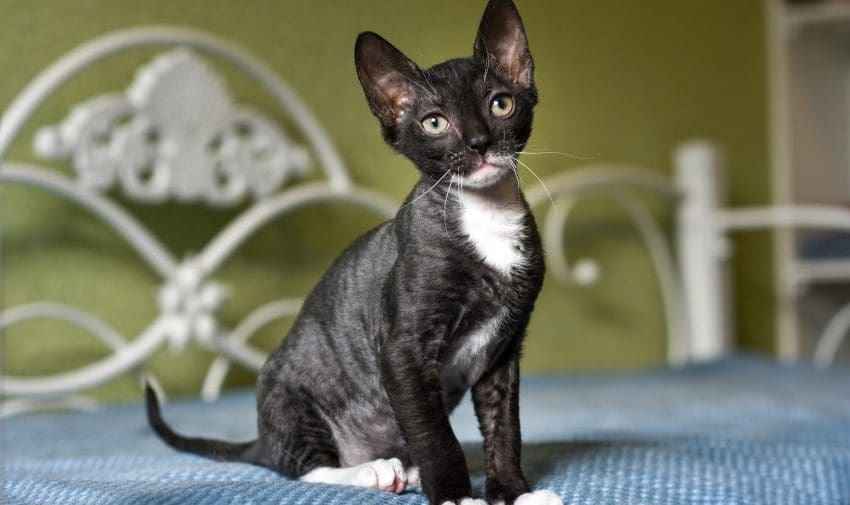
The Ural Rex, a relatively new breed, is a medium-sized, well-muscled cat.
Its curly coat gives it an unusual and interesting appearance. This coat can be medium or short in length, and the waves are “flexible.”
Olga Mironova, a World Cat Congress (WCC) all-breed judge from Russia, introduced the Ural Rex as one of the WCC’s newest breeds.
According to Mrs. Mironova, the curly-haired cat is native to the Ekaterinburg area on the eastern part of the Ural Mountains.
The breed was first sighted in that part of central Russia in the middle of the 20th century. At the 2006 General Assembly, the Ural Rex was confirmed as a recognized breed by the WCC.
The key feature of this breed is the dense, fine coat that lies in double-laying waves. What’s more, this coat develops in various stages as the cat grows older.
When you first meet this feline, you’re sure to notice its charming personality. It’s very good with children, other cats and other animals.
Don’t assume that this feline isn’t strong when you see its medium-sized, relatively short, and slim body. It’s quite alert and active, facilitated by its muscular frame.
The tell-tale characteristics of the Ural Rex’s head and facial features include:
- a short, broad, equilateral wedge shape
- a flat and broad forehead
- slightly curved profile at the lower lip level
- prominent cheekbones with a noticeable pinch
- broad muzzle
- strong chin and lower jaw
The cat certainly makes full use of its medium-long and slender legs.
Wrap-Up
Remember, it’s always better to adopt rather than shop.
If you have your heart set on one of these amazing Russian cat breeds, please contact your local shelters first.
Then, look into breed-specific rescue groups in your area.
What are your thoughts on these Russian cat breeds? Do you have one? Share below!
Resources:
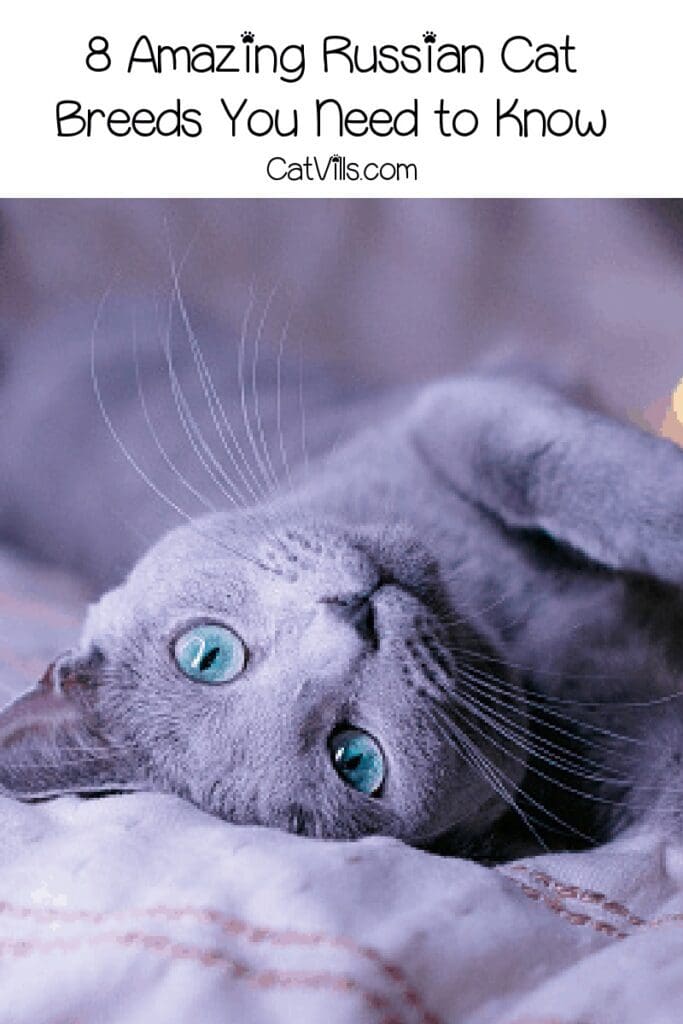

I enjoyed learning about these cats. So many different types of cats in the world.
It’s so beautiful to know more about cats! That White Russian cat is so beautiful!
There were so many beautiful and interesting casts in this group. Some of those cats had the most amazing eyes